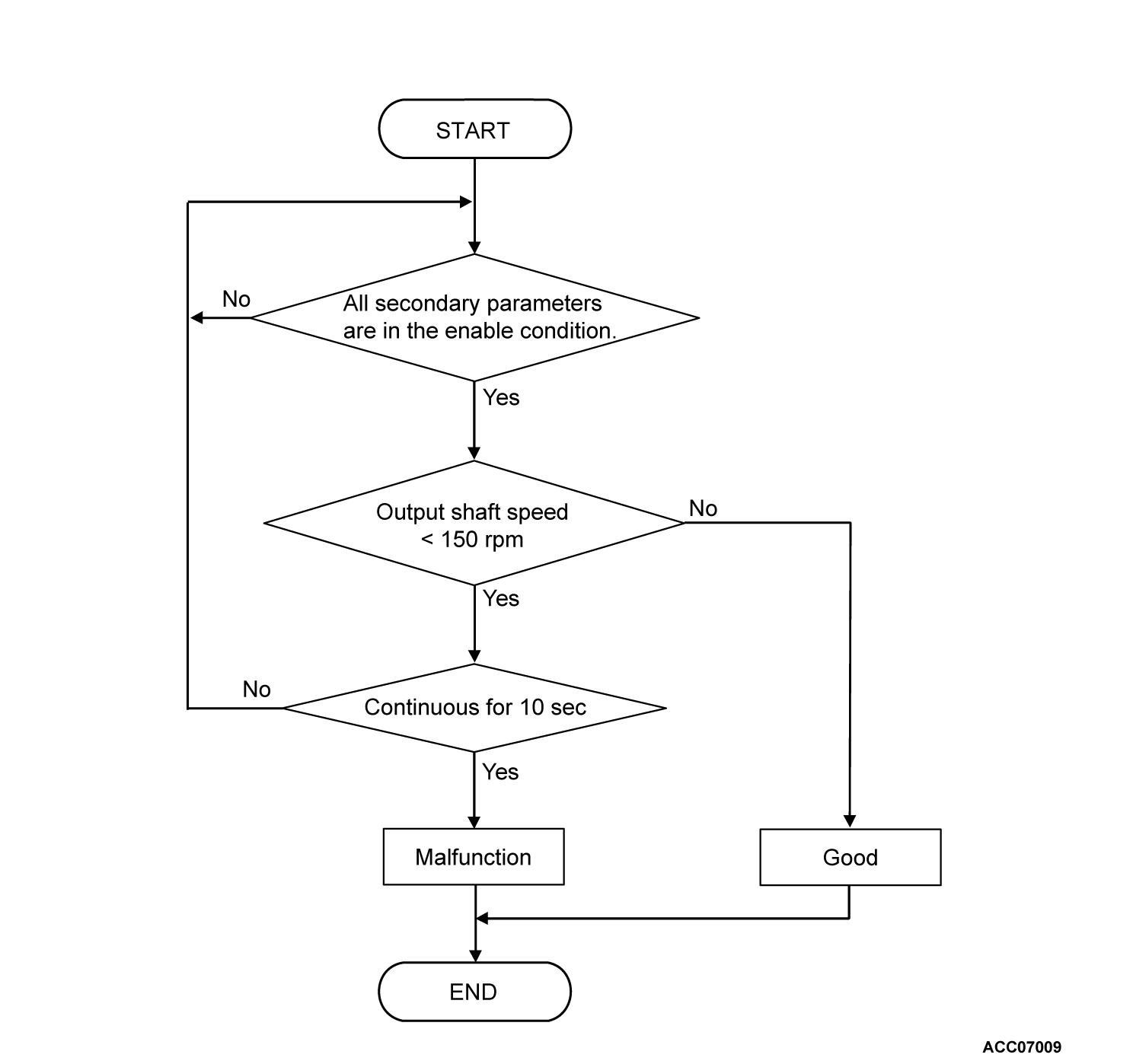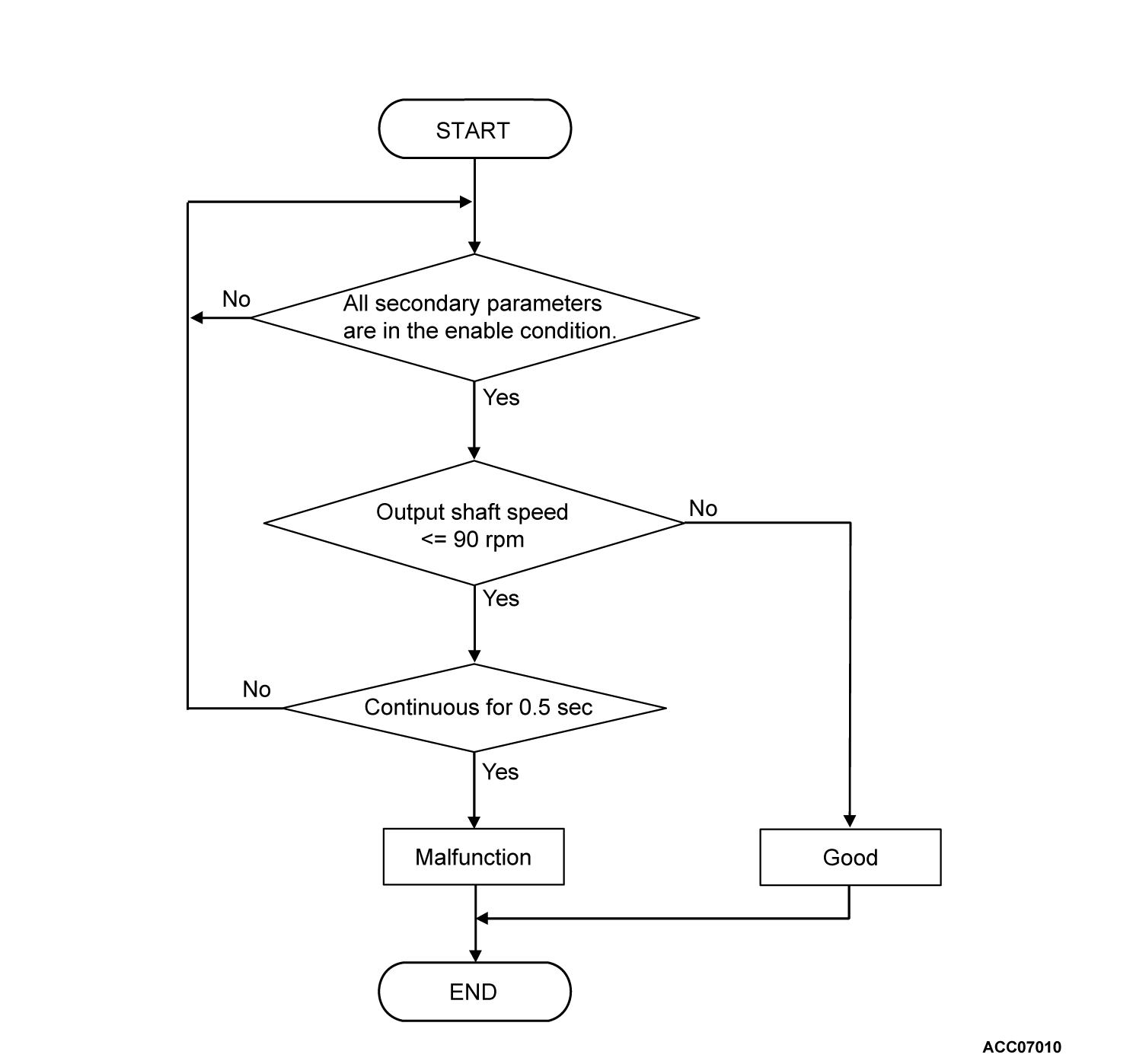DTC P0720: Malfunction of Output Speed Sensor
DIAGNOSTIC FUNCTION
The TCM determines whether the system is faulty by monitoring the output speed sensor.
DESCRIPTIONS OF MONITOR METHODS
- The status with the secondary pulley speed of 1,500 r/min or more and with the output shaft speed of 150 r/min or less continues for 10 seconds.
- When the output shaft speed has dropped abruptly from 730 r/min or more to 90 r/min or less, and then it keeps 90 r/min or less for 0.5 seconds continuously.
MONITOR EXECUTION
- Transmission range: "D", "R" or "L"
MONITOR EXECUTION CONDITIONS (OTHER MONITOR AND SENSOR)
Other Monitor (There is no temporary DTC stored in memory for the item monitored below)
- P0705: Malfunction of transmission range switch
- P0791: Malfunction of secondary pulley speed sensor
Sensor (The sensor below is determined to be normal)
- Transmission range switch
- Secondary pulley speed sensor
DTC SET CONDITIONS
Check Conditions
- Transmission range switch position: "D", "R" or "L"
- Voltage of battery: 10 volts or more
- Voltage of battery: 16.5 volts or less
Judgment Criteria
- The status with the secondary pulley speed of 1,500 r/min or more and with the output speed of less than 150 r/min continues for 10 seconds.
- The output speed has dropped abruptly from 730 r/min or more to 90 r/min or less. Then at least 0.5 seconds have passed with the reduced speed.
OBD-II DRIVE CYCLE PATTERN
The vehicle is driven for at least 20 seconds with the engine speed at 3,500 r/min or more.
PROBABLE CAUSES
- Malfunction of output speed sensor
- Damaged wiring harness and connectors
- Malfunction of TCM
DIAGNOSIS
STEP 1. Check the following connector.
- Output speed sensor connector
Check the terminals for a contact status problem and internal short circuit.
Is the check result normal?
 Repair the faulty connector.
Repair the faulty connector.STEP 2. Check for open circuit in SGN2 line between the output speed sensor connector and the TCM connector.
STEP 3. Voltage measurement at output speed sensor connector (terminal number 1).
(1) Disconnect the output speed sensor connector, and measure at the wiring harness side.
(2) Turn the ignition switch to the "ON" position.
(3) Measure the voltage between the output speed sensor connector (terminal number 1) and body ground.
OK: 10 V or more
Is the check result normal?
 Repair the connector(s) or the wiring harness (power supply line between the output speed sensor connector terminal number 1 and the J/B connector).
Repair the connector(s) or the wiring harness (power supply line between the output speed sensor connector terminal number 1 and the J/B connector).STEP 4. Check the following connector.
- TCM connector
Check the terminals for a contact status problem and internal short circuit.
Is the check result normal?
 Repair the faulty connector.
Repair the faulty connector.STEP 5. Check for open circuit or short to ground in OUTS line between the output speed sensor connector and the TCM connector.
STEP 6. Measure the output wave pattern of the output speed sensor at TCM connector (OUTS terminal).
(1) Connect the output speed sensor connector and TCM connector.
(2) Transmission range: "D" range
(3) Drive at a constant speed of approximately 20 km/h (12.4 mph).
(4) Connect an oscilloscope, and measure the voltage between TCM connector OUTS terminal and body ground.
Is the check result normal?
![[Previous]](../../../buttons/fprev.png)
![[Next]](../../../buttons/fnext.png)



